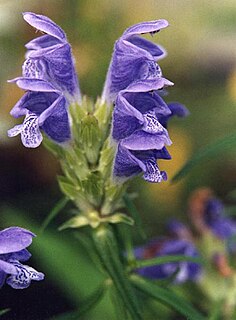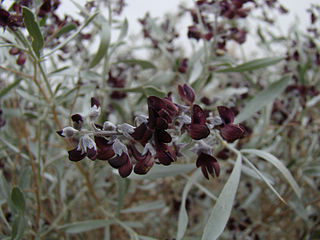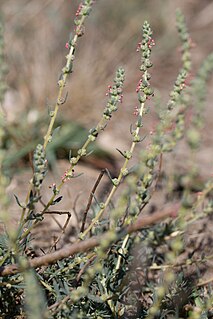
Nepeta is a genus of flowering plants in the family Lamiaceae. The genus name is reportedly in reference to Nepete, an ancient Etruscan city. There are about 250 species.

Dracocephalum is a genus of about 60 to 70 species of flowering plants in the family Lamiaceae, native to temperate regions of the Northern Hemisphere. These flowers, collectively called dragonhead, are annual or perennial herbaceous plants or subshrubs, growing to 15 to 90 centimeters tall.

Ajuga, also known as bugleweed, ground pine, carpet bugle, or just bugle, is a genus of 40 species annual and perennial herbaceous flowering plants in the Ajugeae tribe of the mint family Lamiaceae, with most species native to Europe, Asia, and Africa, but also two species in southeastern Australia. They grow to 5–50 cm tall, with opposite leaves.

The Salsoloideae are a subfamily of the Amaranthaceae, formerly in family Chenopodiaceae.

Isatis is a genus of flowering plants in the family Brassicaceae, native to the Mediterranean region east to central Asia. The genus includes woad. Due to their extremely variable morphology, the Asian species in particular are difficult to determine; the only reliable diagnostic feature is the ripe fruit. They are (usually) biennial or perennial herbaceous plants, often bluish and hairless or downy hairy with the upright stem branched.

Trigonella is a genus from the family Fabaceae. The best known member is the herb fenugreek. Members of the genus occur naturally in the Canary Islands, southern Europe, non‑tropical Africa, western and central Asia, the Indian subcontinent, and Australia.

Aethionema is a genus of flowering plants within the family Brassicaceae. They are known as stonecresses. Stonecresses originate from sunny limestone mountainsides in Europe and West Asia, especially Turkey.

Zygophyllum is the type genus of the flowering plant family Zygophyllaceae. The generic name is derived from the Greek words ζυγόν (zygon), meaning "double", and φυλλον (phyllon), meaning "leaf". It refers to the leaves, each of which have two leaflets. The genus is distributed in arid and semi-arid regions of Africa, the Mediterranean Basin, central Asia and Australia.

Salsola is a genus of the subfamily Salsoloideae in the family Amaranthaceae. The genus sensu stricto is distributed in central and southwestern Asia, North Africa, and the Mediterranean. A common name of various members of this genus and related genera is saltwort, for their salt tolerance. The genus name Salsola is from the Latin salsus, meaning "salty".

Ammodendron is a genus of flowering plants, called the sand acacias, in the legume family, Fabaceae. It belongs to the subfamily Faboideae. Its name is derived from the Greek άμμος ammos ("sand") and δένδρον dendron ("tree").

The Suaedoideae are a subfamily of plants in the family Amaranthaceae.

Anabasis is a genus of plants in the subfamily Salsoloideae of the family Amaranthaceae. It is distributed in southern Europe, North Africa, and Asia.

Ungernia is a genus of bulb-forming plants in the Amaryllis family, native to central and south-central Asia Asia.
Cyclotrichium is a genus of plants in the Lamiaceae, first described as a genus in 1953. The entire genus is endemic to southwestern Asia.
- Cyclotrichium depauperatum(Bunge) Manden. & Scheng. - western Iran
- Cyclotrichium glabrescens(Boiss. ex Rech.f.) Leblebici - southeastern Turkey
- Cyclotrichium haussknechtii(Bunge) Manden. & Scheng. - western Iran
- Cyclotrichium leucotrichum(Stapf ex Rech.f.) Leblebici - Iran, Iraq, Turkey
- Cyclotrichium longiflorumLeblebici - Iran, Iraq, Turkey
- Cyclotrichium niveum(Boiss.) Manden. & Scheng - eastern Turkey
- Cyclotrichium origanifolium(Labill.) Manden. & Scheng. - Lebanon, Syria, southern Turkey
- Cyclotrichium stamineum(Boiss. & Hohen.) Manden. & Scheng. - Iraq, Turkey
- Cyclotrichium straussii(Bornm.) Rech.f. - western Iran

Acanthophyllum is a genus of flowering plant in the family Caryophyllaceae with about 75 species, spread in the Irano-Turanian area.
Haloxylon salicornicum is a shrub or undershrub belonging to the family Amaranthaceae. It is a desert shrub and is found in Israel, Jordan, Egypt, Saudi Arabia, Kuwait, Oman, United Arab Emirates, Afghanistan and Pakistan.

Camphorosma is a genus of flowering plants in the family Amaranthaceae, found in northern Africa, southern and eastern Europe, Crimea, Russia, Anatolia, the Caucasus, Iran, Afghanistan, Pakistan, Central Asia, the Altai, western Siberia, Xinjiang in China, and Mongolia. Annuals or subshrubs, they can be distinguished from closely related taxa such as Bassia by their flattened perianths which have four lobes, inflorescences with multicellular glandular hairs, a distinct C4 leaf anatomy type (called the Camphorosma type), and a chromosome count of 2n = 12.

Leptopus chinensis is a species of plant belonging to the family Phyllanthaceae.
Caccinia is a genus of flowering plants belonging to the family Boraginaceae.














